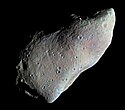Małe ciało Układu Słonecznego

Małe ciało Układu Słonecznego – obiekt astronomiczny krążący wokół Słońca, który nie jest ani planetą, ani planetą karłowatą.
Do małych ciał Układu Słonecznego należą:
- większość planetoid (z wyjątkiem planety karłowatej Ceres)
- większość obiektów transneptunowych (niebędących plutoidami)
- komety
- inne małe ciała (np. meteoroidy)
Termin „małe ciało Układu Słonecznego” został przyjęty przez Międzynarodową Unię Astronomiczną na jej XXVI Zgromadzeniu Ogólnym w sierpniu 2006 roku.
Media użyte na tej stronie
This is a revised version of Solar_System_XXIX.png.
Asteroid en:951 Gaspra.
Calvin J. Hamilton's website View of the Solar System describes this image as follows:
- "This picture Gaspra is a combination of the highest-resolution images and color information obtained by the Galileo spacecraft. The Sun is shining from the right. The subtle color variations on Gaspra's surface have been exaggerated. en:Albedo and color variations are associated with surface en:topography. The bluish areas are regions of slightly higher albedo and tend to be associated with some of the crisper craters and with ridges. The slightly reddish areas, apparently concentrated in low areas, represent regions of somewhat lower albedo. In general, such patterns can be explained in terms of greater exposure of fresher rock in the brighter bluish areas and the accumulation of some en:regolith materials in the darker reddish areas. (Courtesy USGS/NASA/JPL)" [1]

